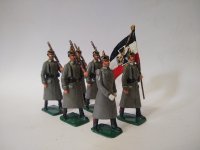...As part of my educational journey, could you explain the term "recast" in a little more detail? I'm assuming they would not have procured the original molds from Britains. Would they have made their own molds using an actual Britains soldier? Or, is there something else in play in this process?
"Recast" has a negative connotation, as in "unauthorized copy of a copyrighted item." It's synonymous with piracy. Not usually applied in the context of a hobbyist making a copy for himself, though that may violate the original maker's copyright, too. It usually means toy soldiers sold as originals, but which are unauthorized copies. The scale of the copying effort can range from the hobbyist previously mentioned, who might make a mold and cast some items for himself, all the way up to commercial operations that produce hundreds of copies. Red China and Russia are two countries home to such operations, especially Red China. Though recasting isn't restricted to those two.
And today, with 3D printing, piracy is even easier to do. And it's not just toy soldiers or connoisseur toys (eg, King & Country) that are prey. Connoisseur figures are often pirated, and in such cases, the original producer might be a one-man operation, not a large company, and he feels the theft even more acutely.
In the case of figures made with approval, under license, say, such as Ron Ruddell had, "recast" isn't usually used. Rather, we'd say that such figures are reproductions, or licensed or authorized.
It'll never be completely eliminated, though. We can only educate ourselves as best we can, and when we find something we think is a recast, report it to the original maker and to the platform where we spotted it. The original maker is usually in the best position to pursue action, though the platform might take action, too. In my experience, that has most often been eBay, and they've done nothing.
Prost!
Brad



![312 [8pc; £35 in 2017; mixed 1948:9V].jpg](/data/attachments/295/295239-f5dce0af877fbe4683b141841ea5faee.jpg)